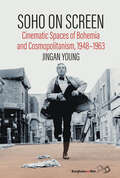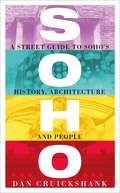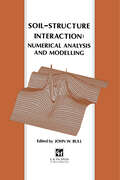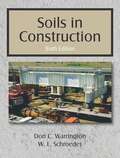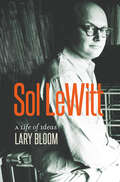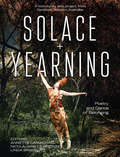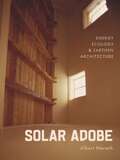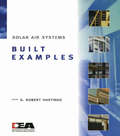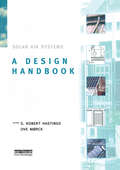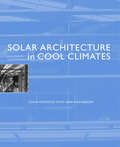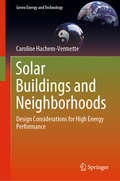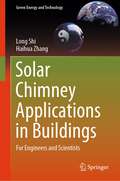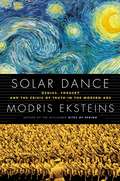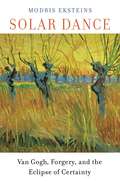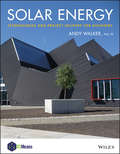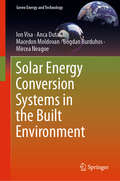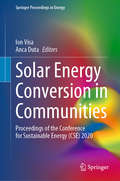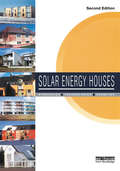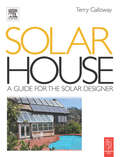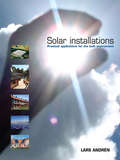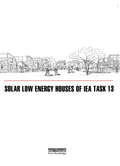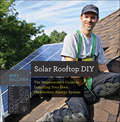- Table View
- List View
Soho on Screen: Cinematic Spaces of Bohemia and Cosmopolitanism, 1948-1963
by Jingan YoungDespite Soho’s rich cultural history, there remains an absence of work on the depiction of the popular neighbourhood in film. Soho on Screen provides one of the first studies of Soho within post-war British cinema. Drawing upon historical, cultural and urban studies of the area, this book explores twelve films and theatrically released documentaries from a filmography of over one hundred Soho set productions. While predominantly focusing on low-budget, exploitation films which are exemplars of British and international filmmaking, Young also offers new readings of star and director biographies, from Laurence Harvey to Emeric Pressburger, and in so doing enlivens discussion on filmmaking in a time and place of intense social transformation, technological innovation and growing permissiveness.
Soho: A Street Guide to Soho's History, Architecture and People
by Dan CruickshankSoho - illicit, glamorous, sordid, louche, poverty-stricken, squalid, exhilarating. One of Britain's best-loved historians, Dan Cruickshank, grants us an intimacy with centuries of rich and varied history as he guides us around the Soho of the last five hundred years. We learn of its original aspirations towards respectability, how it became London's bohemian quarter and why it was once home to its criminal underworld. The bars, clubs, theatres and their frequenters are described with detail that evokes the heart of the district. The history of Soho is written in its surviving architecture. Cruickshank points out the streets that were the stamping grounds of criminal dynasties and directs our attention towards the homes of renowned prostitutes, revealing Georgian sexual mores and surprising visitors - amongst them eighteenth-century painter Joshua Reynolds, whose peculiar 'caprice' was simply drawing the girls. Soho has been home to characters as diverse as Mrs Goadby's girls to the Maltese mafia, and Cruikshank draws these threads together with kaleidoscopic verve. Even as he mourns some of the changes, he pays testament to the district's resilience. He observes how the common denominator over the centuries is that it has always been a destination for immigrants: from French Huguenots to the East European Jewish community and recent Chinese diaspora - and that this is the foundation of its spirit and success.
Soho: A Street Guide to Soho’s History, Architecture and People
by Dan CruickshankSoho - illicit, glamorous, sordid, louche, poverty-stricken, squalid, exhilarating. One of Britain's best-loved historians, Dan Cruickshank, grants us an intimacy with centuries of rich and varied history as he guides us around the Soho of the last five hundred years. We learn of its original aspirations towards respectability, how it became London's bohemian quarter and why it was once home to its criminal underworld. The bars, clubs, theatres and their frequenters are described with detail that evokes the heart of the district. The history of Soho is written in its surviving architecture. Cruickshank points out the streets that were the stamping grounds of criminal dynasties and directs our attention towards the homes of renowned prostitutes, revealing Georgian sexual mores and surprising visitors - amongst them eighteenth-century painter Joshua Reynolds, whose peculiar 'caprice' was simply drawing the girls. Soho has been home to characters as diverse as Mrs Goadby's girls to the Maltese mafia, and Cruikshank draws these threads together with kaleidoscopic verve. Even as he mourns some of the changes, he pays testament to the district's resilience. He observes how the common denominator over the centuries is that it has always been a destination for immigrants: from French Huguenots to the East European Jewish community and recent Chinese diaspora - and that this is the foundation of its spirit and success.
Soil-Structure Interaction: Numerical Analysis and Modelling
by John W. BullThis book describes how a number of different methods of analysis and modelling, including the boundary element method, the finite element method, and a range of classical methods, are used to answer some of the questions associated with soil-structure interaction.
Soils in Construction
by Don C. Warrington W. L. SchroederMost geotechnical books on soil mechanics or foundations focus exclusively on the needs of engineers. But the increasing complexity of the construction environment requires construction and engineering managers to know more about engineering requirements. Soils in Construction provides students in those disciplines with the necessary background to make informed decisions about soils. Every chapter of the Sixth Edition has been thoroughly updated, with all examples made even more clear and easier for students to follow. Many photos illustrate the concepts and applications of soils and geotechnical structures throughout the book. An appendix detailing lab procedures allow the book to serve those courses with a lab component while still maintaining flexibility for those without.
Soja-Kerzen: Enthüllung der besten Lieferanten für den Kerzenzubehör
by Amber RichardsHast du dich jemals gefragt, ob du wirklich erstaunliche Sojakerzen von hoher Qualität zu Hause herstellen kannst? Kerzen aus Sojawachs, die stark duften und tatsächlich richtig abbrennen? Wie sieht es mit der Fähigkeit aus, deine Freunde und Familie mit selbstgemachte Geschenke, die sie wirklich lieben, zu beeindrucken? Amber Richards stellte seit vielen Jahren ihre eigenen Sojakerzen im Glas her und betrieb mit diesen Kerzen ein Heimgeschäft. In diesem Buch werden die Techniken zur Herstellung von qualitativ hochwertigen Soja-Kerzen in Behältern klar beschrieben. Sie verrät auch ihre liebsten Kerzenlieferanten, da sie festgestellt hat, dass dies eine große Hürde für viele Personen war, die dieses Projekt durchführen wollten, und es zählte auch zu den am häufigsten gestellten Fragen. In diesem eBook geht es weniger um den geschäftlichen Aspekt der Kerzenherstellung, sondern konzentriert sich auf den kreativen "How-to"-Prozess der Herstellung dieser Kerzen in Gläsern. Informiere dich über die richtigen Techniken des Kerzenbrennens und welche Eigenschaften eine Kerzen von größter Qualität ausmacht. Das Gießen von Kerzen ist eine genussvolle und entspannende Tätigkeit. Und am Ende wird eine fertige Kerze dabei entstehen, bei der du stolz sagen kannst: „Die habe ich gemacht".
Sol LeWitt: A Life of Ideas (The\driftless Connecticut Series And Garnet Bks.)
by Lary BloomSol LeWitt (1928-2007), one of the most influential artists of the twentieth century, upended traditional practices of how art is made and marketed. A key figure in minimalism and conceptualism, he proclaimed that the work of the mind is much more important than that of the hand. For his site-specific work—wall drawings and sculpture in dozens of countries—he created the idea and basic plan and then hired young artists to install the pieces. Though typically enormous and intricate, the physical works held no value. The worth was in the pieces of paper that certified and described them. LeWitt championed and financially supported colleagues, including women artists brushed aside by the bullies of a male-dominated profession. Yet the man himself has remained an enigma, as he refused to participate in the culture of celebrity. Lary Bloom's book draws on personal recollections of LeWitt, whom he knew in the last years of the artist's life, as well as LeWitt's letters and papers and over one hundred original interviews with his friends and colleagues, including Chuck Close, Ingrid Sischy, Philip Glass, Adrian Piper, Jan Dibbets, and Carl Andre. This absorbing chronicle brings new information to our understanding of this important artist, linking the extraordinary arc of his life to his iconic work. Includes 28 illustrations.
Solace + Yearning – Poetry of Dance and Belonging: A Community Arts Project from Denmark, Western Australia
by Annette Carmichael‘Solace + Yearning’ layers landscape, poetry, eco-art and contemporary dance to create an immersive space for many voices: yearning to connect to country, grief for what is absent, and reaching towards an understanding of indigenous language and culture. “Along the edges, voices call softly, softly… the past speaking to the present.” This multi-arts collaboration explores ‘settler guilt’ and ‘solastalgia’—a sense of loss caused by environmental change—in a small rural community. The work unravels contradictory and complicated feelings about Australia’s stories, the assumed advantage of non-indigenous Australians, and yet our deep longing for the wisdom and connection intrinsic in indigenous cultures. “It is beneath the bark where stories are whispered and life rises to stitch together this river with this sky.” Performed in Denmark, Western Australia in 2012, and again as a solo performance by Annette Carmichael in 2014, these images and reflections portray a complex relationship between people and place. “Sometimes, sometimes I make the mistake of thinking that what has not been written down has been forgotten.” With gratitude to Joey Williams, Wayne Webb, Toni Webb, and Harley Coyne, who walked the trail with us and generously shared their Noongar culture and stories.
Solar Adobe: Energy, Ecology, and Earthen Architecture
by Albert NarathHow a centuries-old architectural tradition reemerged as a potential solution to the political and environmental crises of the 1970s Against the backdrop of a global energy crisis, a widespread movement embracing the use of raw earth materials for building construction emerged in the 1970s. Solar Adobe examines this new wave of architectural experimentation taking place in the United States, detailing how an ancient tradition became a point of convergence for issues of environmentalism, architecture, technology, and Indigenous resistance. Utilized for centuries by the Pueblo people of the American Southwest and by Spanish colonialists, adobe construction found renewed interest as various groups contended with the troubled legacies of modern architecture and an increasingly urgent need for sustainable design practices. In this period of critical experimentation, design networks that included architects, historians, counterculture communities, government weapons labs, and Indigenous activists all looked to adobe as a means to address pressing environmental and political issues. Albert Narath charts the unique capacities of adobe construction across a wide range of contexts, consistently troubling simple distinctions between traditional and modern technologies, high design and vernacular architecture. Drawing insightful parallels between architecture, environmentalism, and movements for Indigenous sovereignty, Solar Adobe stresses the importance of considering the history of the built environment in conjunction with architecture&’s larger impact on the natural world.
Solar Air Systems - Built Examples
by Robert HastingsThirty-five different buildings with successfully installed solar air systems are described and documented. The building types cover single family houses, apartment buildings, schools, sports halls, and industrial commercial buildings with six different configurations of solar air systems used. Each example building is described over several pages, with plans, performance details and illustrations provided. This is supplemented by a summary of the types of system used.
Solar Air Systems: A Design Handbook
by Robert HastingsActive solar systems for air heating are a straightforward yet effective way of using solar energy for space heating and tempering ventilation air. They offer some unique advantages over solar water systems, can offer improved comfort and fuller use of solar gains than passive solar systems and are a natural fit with mechanically ventilated buildings. They can be economical, with short pay-back periods and can act not only as space heating or ventilation air heating but also for water pre-heating, sunshading, electricity generation (with hybrid photovoltaic systems) and can help induce cooling. This design handbook takes architects and building engineers through the process of designing and selecting an active solar system from the six types presented, optimizing the system using nomograms and curves, and finally dimensioning the components of the system. Tips are offered regarding the construction and how to avoid problems. The book will provide essential design information for all architects, building engineers and other building design professionals and all those concerned to reduce the environmental impact of buildings.
Solar Architecture in Cool Climates
by Colin Porteous'A must-read for practitioners, teachers and others interested in or working with energy use in the built environment, including a delightful set of examples' Ann Grete Hestnes, former President of the International Solar Energy Society Solar Architecture in Cool Climates is an invaluable primer on low energy building design, combining accessible information with convincing arguments enabling new techniques to be implemented in daily practice. Approaching the topic in a thematic manner, the book provides inspiration, an understanding of key principles and technical data on the design of solar buildings in higher latitudes. The text is enlivened through direct experience of case studies from Europe and North America dealing with new-build, retrofitting and conceptual projects that outline future potential (the principles being equally applicable to equivalent southern latitude locations. The authors examine the dilution of additional costs through different strategies, the tensions between energy efficiency and environmental quality, and the proactive control of energy in building design. Promoting flexibility and opportunity to a diverse audience, including those who use, procure and finance buildings, the book aims to bring the design of 'green' solar buildings in cool climates from special interest status into the mainstream. Broader environmental issues relating to solar architecture are addressed in the final chapter, again drawing on case studies from the authors' own wide experience. Solar Architecture in Cool Climates is written for architects and other building designers, students of architecture and other professionals interested in sustainable architecture, renewable energy and engineering.
Solar Buildings and Neighborhoods: Design Considerations for High Energy Performance (Green Energy and Technology)
by Caroline Hachem-VermetteThis book presents the main principles for designing buildings and neighborhoods with increased potential to capture and utilize solar energy. It discusses practical issues in the design of the built environment and their impact on energy performance; and a range of design considerations, from building components (e.g. the building envelope) to urban planning issues (e.g. density and street layouts). In addition to design guidelines on how to increase buildings’ potential to capture solar energy, the book provides creative tips to increase the aesthetic value of solar technology integration in buildings. Helping readers plan energy-efficient buildings with innovative building envelope technologies, and to understand the impact of early-stage design considerations on the energy performance of buildings and communities, the book offers a valuable source of information for building professionals, including architects, engineers, and urban planners. It can also serve as a reference guide for academics and students of energy efficiency in buildings and urban planning.
Solar Chimney Applications in Buildings: For Engineers and Scientists (Green Energy and Technology)
by Long Shi Haihua ZhangThis book comprehensively describes the operating principles and theoretical foundations of solar chimneys. It covers current research results, including numerical analysis and mathematical models based on different assumptions. Complying with the application of renewable energy in sustainable buildings, solar chimney has received extensive attention as an indispensable part natural ventilation. This book is a guide to the application of solar chimneys from single zones to multi zones, and it provides a reference source of application for construction practitioners and engineering decision-makers. The design basis and the related basic principles of fluid mechanics and natural ventilation design strategies introduced in this book will also be beneficial to college students.
Solar Dance
by Modris EksteinsIn Solar Dance, acclaimed writer and scholar Modris Eksteins uses Vincent van Gogh as his lens for this brilliant survey of Western culture and politics in the last century. The long-awaited follow-up to Modris Eksteins' internationally acclaimed Rites of Spring and Walking Since Daybreak. Now he has produced another thrilling, iconoclastic work of cultural history that is a trailblazing biography of an era--from the eve of the First World War and the rise of Hitler to the fall of the Berlin Wall--that illuminates our current world, with its cults of celebrity and the crisis of the authentic. Solar Dance is a penetrating examination of legitimacy and truth, fakery and pretence--highly relevant to all of us today.From the Hardcover edition.
Solar Dance: Van Gogh, Forgery, and the Eclipse of Certainty
by Modris EksteinsIn Modris Eksteinss hands, the interlocking stories of Vincent van Gogh and art dealer Otto Wacker reveal the origins of the fundamental uncertainty that is the hallmark of the modern era. Through the lens of Wackers sensational 1932 trial in Berlin for selling fake Van Goghs, Eksteins offers a unique narrative of Weimar Germany, the rise of Hitler, and the replacement of nineteenth-century certitude with twentieth-century doubt. Berlin after the Great War was a magnet for art and transgression. Among those it attracted was Otto Wacker, a young gay dancer turned art impresario. His sale of thirty-three forged Van Goghs and the ensuing scandal gave Van Goghs work unprecedented commercial value. It also called into question a world of defined values and standards that had already begun to erode during the war. Van Gogh emerged posthumously as a hero who rejected organized religion and other suspect sources of authority in favor of art. Self-pitying Germans saw in his biography a series of triumphs-over defeat, poverty, and meaninglessness-that spoke to them directly. Eksteins shows how the collapsing Weimar Republic that made Van Gogh famous and gave Wacker an opportunity for reinvention propelled a third misfit into the spotlight. Taking advantage of the void left by a gutted belief system, Hitler gained power by fashioning myths of mastery. Filled with characters who delight and frighten, "Solar Dance" merges cultural and political history to show how upheavals of the early twentieth century gave rise to a search for authenticity and purpose.
Solar Energy
by Andy WalkerSolar Energy is an authoritative reference on the design of solar energy systems in building projects, with applications, operating principles, and simple tools for the construction, engineering, and design professional. The book simplifies the solar design and engineering process, providing sample documentation and special tools that provide all the information needed for the complete design of a solar energy system for buildings to enable mainstream MEP and design firms, and not just solar energy specialists, to meet the growing demand for solar energy systems in building projects.
Solar Energy Conversion Systems in the Built Environment (Green Energy and Technology)
by Ion Visa Anca Duta Macedon Moldovan Bogdan Burduhos Mircea NeagoeThis book focuses on solar energy conversion systems that can be implemented in the built environment, at building or at community level. The quest for developing a sustainable built environment asks for specific solutions to provide clean energy based on renewable sources, and solar energy is considered one of the cleanest available energy on Earth. The specific issues raised by the implementation location are discussed, including the climatic profile distorted by the buildings, the available surface on the buildings for implementation, etc. This book also discusses the seasonal and diurnal variability of the solar energy resource in parallel with the variability of the electrical and thermal energy demand in the built environment (particularly focusing on the residential buildings). Solutions are proposed to match these variabilities, including the development of energy mixes with other renewables (e.g. geothermal or biomass, for thermal energy production). Specific solutions, including case studies of systems implemented on buildings all over the world, are presented and analyzed for electrical and for thermal energy production and the main differences in the systems design are outlined. The conversion efficiency (thus the output) and the main causes of energy losses are considered in both cases. The architectural constraints are additionally considered and novel solar energy convertors with different shapes and colors are presented and discussed. The durability of the solar energy conversion systems is analyzed considering the specific issues that occur when these systems are implemented in the built environment; based on practical examples, general conclusions are formulated and specific aspects are discussed in relation to experimental results and literature data. With renewables implemented in the built environment likely to expand in the near future, this book represents welcome and timely material for all professionals and researchers that are aiming to provide efficient and feasible solutions for the sustainable built environment.
Solar Energy Conversion in Communities: Proceedings of the Conference for Sustainable Energy (CSE) 2020 (Springer Proceedings in Energy)
by Ion Visa Anca DutaThis book presents novel findings concerning the systems, materials and processes used in solar energy conversion in communities. It begins with the core resource – solar radiation – and discusses the restrictions on the wide-scale implementation of conversion systems imposed by the built environment, as well as potential solutions. The book also describes efficient solar energy conversion in detail, focusing on heat and electricity production in communities and water reuse. Lastly, it analyzes the concept of sustainable communities, presenting examples from around the globe, along with novel approaches to improving their feasibility and affordability. Though chiefly intended for professionals working in the field of sustainability at the community level, the book will also be of interest to researchers, academics and doctoral students.
Solar Energy Houses: Strategies, Technologies, Examples
by Robert Hastings Anne-Grete Hestnes Bjarne SaxhofPassive and active solar strategies together with the adoption of energy conservation measures and the integration of new materials and technologies can lead to a dramatic reduction of 75-90 per cent in the energy consumption of the buildings. The objective of Task 13 of the IEA's Solar Heating and Cooling Programme was to advance solar building technologies and demonstrate this potential by designing and constructing buildings that met very low energy consumption targets while maintaining a good indoor climate. This revised second edition of this book presents the findings of the Task 13 experts and includes the results of the monitoring programme, conducted to determine the effectives of the techniques and strategies adopted. This new edition also provides a detailed explanation of this research programme in terms of how far the expectations of the Task experts were met and highlights the specific successes and lessons learned from the project.
Solar Home Design Manual for Cool Climates
by Shawna Henderson Don RoscoeIf you want an inexpensive, environmentally sound source of energy for your home, you need look no further than the sun. Solar heat is not subject to rate increases, is totally renewable, pollution free and requires little or no technology. It is here for you today, and can easily provide up to 50% of your space and water heating requirements. This is a book that simply and clearly explains the principles of using solar energy to heat your home. Anyone building a new home, or renovating an old one can incorporate one or several aspects of solar energy into their design. Taking you through the process of designing a solar home from the ground up this manual is also a basic course in conservation and sustainable house design. If you live in a 'heating' climate, meaning if you have space heating requirements for most of the year then this is an invaluable resource. A house is the biggest single investment most of us will make in our lives - the way it is built and how it operates can reflect a long term investment in both the building and the planet.
Solar House: A Guide For The Solar Designer
by Terry GallowayCovering the full life span of the project, from siting issues through specific design features to maintenance of the property and equipment, this is a comprehensive guide to designing, planning and building a solar house. The author uses his experience of living in a solar house to inform the reader of the technology and practices needed for the design, operation and maintenance of the solar home. Each of the technologies of the house, such as space heating and cooling, domestic hot water and electric power technologies, are critiqued from the point of view of the owner/resident, with the author using his thirty years experience of living in a solar home. This provides home owners who are thinking of going solar with first hand evidence of best practice, and provides the architect and designer with the knowledge of how to best satisfy their clients needs.
Solar Installations: Practical Applications for the Built Environment
by Lars AndrenSolar energy will play an important role in our future energy supply, to the advantage of both the environment and the economy. This book focuses on water-based solar heating technology, presenting basic principles on solar radiation and the solar heating system, including details on orientation and output, sizing, the solar collector, the solar circuit, heat exchangers, heat stores and overall system technology. A range of practical applications are described, such as multi- and single-family dwellings, pools, camp sites, sports facilities, schools and industry. The potential and diversity of solar energy is made clear with additional sections on solar electricity, passive solar and solar air heating.
Solar Low Energy Houses of IEA Task 13
by Robert HastingsThe International Energy Agency's Task 13 is to advance solar building technologies. As part of that programme, 15 houses in 12 countries have been built to test new technologies and strategies for achieving low energy demand while maintaining a good indoor climate.;The principal strategies used and evaluated are: minimization of heat losses, profiting from passive solar and internal gains, heating with an active solar system, heating with recovered heat and providing auxiliary heat efficiently.;For each house, this work provides a list of energy features incorporated, an analysis of energy demand, a floor plan, and a description of methods of construction. The houses range from apartment blocks to detached and terraced housing. Local weather conditions, building styles and cultural requirements are taken into consideration.
Solar Rooftop DIY: The Homeowner's Guide to Installing Your Own Photovoltaic Energy System (Countryman Know How)
by Mike SullivanThe do-it-yourself guide for converting your home to solar power Solar energy is clean, efficient, sustainable--and expensive. Or is it? Many homeowners simply assume that the cost of solar panels is out of their reach, but in reality, the technology is quickly becoming attainable for the middle class. Rather than leasing panels from one of those home solar startups (and letting them reap the financial benefits), why not join the thousands who are doing it themselves? In Solar Rooftop DIY, sustainable energy expert Mike Sullivan offers five design plans--ranging from a few simple panels to a complex, roof-covering array--for building a rooftop PV energy system for any home. Each plan has clear and detailed step-by-step photographs showing the installation process. Many of them require no additional labor--just a few days' commitment for the average weekend warrior. With energy costs only set to increase in the future, now is the time to make the switch to solar and start selling power back to the grid.
